An insole is a simple assistive device inserted into the shoe to absorb shocks and promote proper foot alignment.
Insoles have come a long way in the past 50 years. They are now available in an array of specialty designs intended to address specific conditions such as plantar fasciitis, overpronation, and more.
Below is our list of the 10 best insoles on the market, updated for 2023.
Rankings
1. Dr. Scholl’s Pain Relief Orthotics
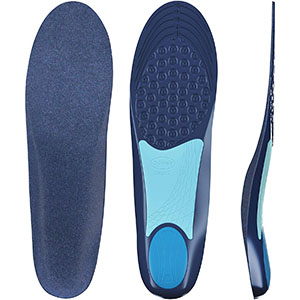
Click here for the lowest price on Amazon
When it comes to consumer-grade foot care products, Dr. Scholl’s is ubiquitous. Their Pain Relief Orthotics are comfortable, versatile, and effective. They’re great insoles for alleviating general foot pain and discomfort.
What we like: We like the dependable quality of these insoles. We also like that they fit easily into different types of footwear and that they’re easy to trim (if necessary).
Flaws: Don’t get confused by the name. These are insoles, not custom orthotics.
Flaws: If you have wide feet, you may find these a bit narrow. Also, if you’re expecting these to be cushy soft you’ll be disappointed.
2. Hydrofeet Liquid Massaging Insoles
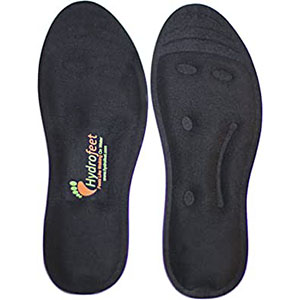
Click here for the lowest price on Amazon
Hydrofeet Liquid Massaging Insoles sound like a gimmick. But they deliver for those who spend all day on their feet. Even if you just get sore feet walking through the market on the weekend, these will help.
What we like: These insoles provide robust cushioning for tired feet. We were also pleasantly surprised by the level of arch support. The fact that you can toss them in the washing machine is also a big plus.
Flaws: They might be a bit too cushy for some folks. And they are not the most durable insoles on the market.
3. Physix Full Length Orthotic Inserts
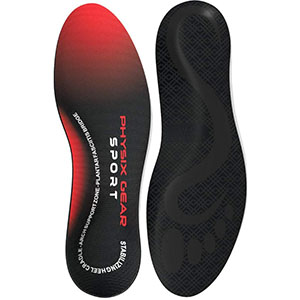
Click here for the lowest price on Amazon
Physix Full Length Orthotic Inserts promise the sun and the moon and mostly deliver. They’re fashioned from PU leather and EVA foam, and the combination is very comfortable. They provide good to outstanding support through the arch.
What we like: We like the level of arch support. We appreciate how agreeable they feel against the sole of the foot. The materials seem first-rate, they fit easily into a variety of shoe types, and the heel cup does a good job promoting stability.
Flaws: The cushioning in the heel is pretty modest, which kind of surprised us. And you may have to trim them a bit to fit them into your shoes.
4. Wernies Running Shoe Inserts
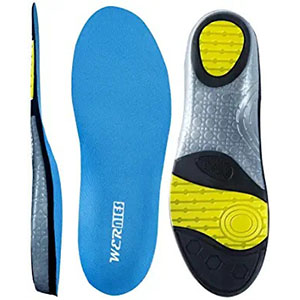
Click here for the lowest price on Amazon
Wernies may not have the brand recognition of Dr. Scholl’s, but their Running Shoe Inserts are right up there in the quality department. Slip a pair of these into your athletic shoes, and you’re good to go for the whole day.
What we like: The arch support doesn’t waver throughout the day. They’re durable and comfortable and don’t irritate the sole of your foot. And the heel cup stabilizes your foot to promote good posture and proper motion.
5. Walk Hero Plantar Fasciitis Feet Insoles
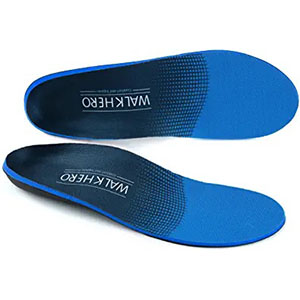
Click here for the lowest price on Amazon
If you have arch-related foot pain, these Walk Hero insoles are likely to provide relief. The cushioning isn’t going to set any records, but the support is hard to beat. They’re compatible with all kinds of shoes, and best of all, they won’t break your bank.
What we like: We like the gentle but unmistakable way these insoles take control of your feet. Also, we appreciate that the fabric avoids turning your shoes into sweat boxes. And that the insoles stay put inside your shoes.
Flaws: Great for people with arch or heel pain. Maybe not so great for those with more general foot pain caused by long hours standing up.
6. Spenco Polysorb Insoles
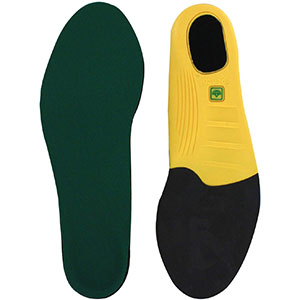
Click here for the lowest price on Amazon
The Spenco Polysorb Insoles leverage their unique shape to produce outstanding support and comfort. They’ll cost you a bit more than some other insoles. But if your feet tire easily after a short time in your shoes, you should give them a whirl.
What we like: If you are looking for a combination of cushioning and arch support, you’ll get it from these Spenco insoles. They’re very comfy, fit in various types of shoes and do a great job absorbing shocks.
Flaws: They may be too thick to put into athletic shoes. And while we like the forefoot crashpad, it’s likely to be the first point of failure.
7. Hyperspace Plantar Fasciitis Arch Support Insoles
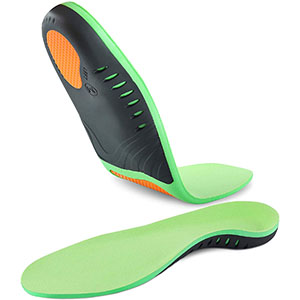
Click here for the lowest price on Amazon
These Hyperspace insoles are marketed as providing plantar fasciitis relief. And they’ll do an excellent job of that. But they also provide good to very good relief from the everyday stress and strain your feet and legs experience.
What we like: These do a good job correcting overpronation. They’re also comfortable and well-made, as well as being very affordable. They’re one of the few we’d recommend for use in hiking boots.
Flaws: They’re pretty thick, so you will likely have to remove any factory installed inserts if you want to use them.
8. Superfeet Carbon Insoles
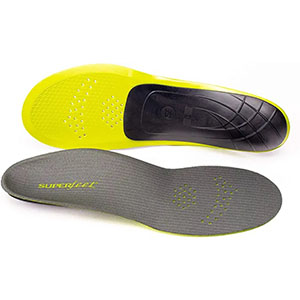
Click here for the lowest price on Amazon
Superfeet Carbon Insoles are all about correcting foot alignment and providing arch support. They’re for people with pronation or supination issues or those who suffer from plantar fasciitis. And for what they are, they do a great job.
What we like: These are good for people who just want a bit more support than their shoes are providing. They do a decent job alleviating arch and heel pain and promoting proper foot alignment. And they’re thin enough to fit into your finest shoes.
Flaws: They provide very little support for the ball of the foot. Also, for the price, we expected them to be a bit more comfortable than they are.
9. Kaps Premium Orthotic Leather Insoles
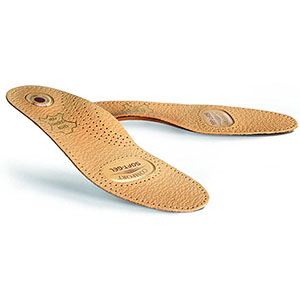
Click here for the lowest price on Amazon
Kaps Premium Orthotic Leather Insoles are for those with fallen arches or those who suffer from plantar fasciitis. They’re built to last, keep your feet surprisingly cool, and aren’t recycling nightmares.
What we like: Those who just want some extra support under their arch will appreciate these. They’re well made, fairly rigid, and thin enough for all your shoes. They’re one of the few insoles you’ll find made from leather.
Flaws: Those who want lots of cushioning are not going to find it here. These are strictly arch support insoles.
10. Foot Active Arch Support Insoles
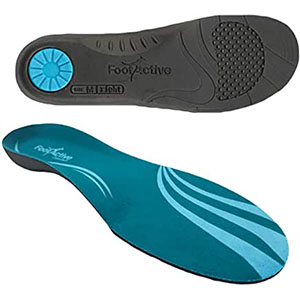
Click here for the lowest price on Amazon
Foot Active Arch Support Insoles are effective and affordable. Which means they’re a good value. They’re particularly helpful for those with fallen arches or who suffer from heel pain. The materials and build quality are first-rate, and they’re bound to last a good long time.
What we like: The degree of support these insoles give the arch of the foot is pretty impressive. If you suffer from plantar fasciitis, these should certainly help. They’re also light, sleek, and fit neatly into your dress shoes.
Flaws: Not for waiters or nurses or others who spend long hours on their feet. Unless they suffer from plantar fasciitis. Why? Just not enough cushioning.
Who Needs Insoles?
You have a plethora of shoe choices today, more than at any time in history. Not only do you have more shoes to pick from, but you have more specialized shoes to pick from than ever before. Need a shoe just for weightlifting? No problem. A shoe for running? Got it. How about ‘golf sandals’ or hiking boots for diabetics or maybe shoes specifically designed for badminton? Got it, got it, got it.
However, in spite of the fact that high quality specialty shoes abound, almost none of these shoes effectively address common foot problems like overpronation (1), oversupination (2), plantar fasciitis (3) or flat feet (4). And that’s where insoles come in. While some manufacturers place inserts into their shoes most of them are of little practical use for someone with one of the above listed conditions. You need the type of insoles on our list.
These insoles occupy a middle ground between factory installed inserts and custom made orthotics (5). The terms ‘insoles’ and ‘orthotics’ are often used interchangeably (and you’ll see that in the brand names on our list), but they are really two different things. Insoles are an OTC item, while orthotics are typically custom-designed by your doctor specifically for your feet.
How We Ranked
Because different foot conditions call for different remedies, all commercially available insoles cannot be examined under the same light. As such, what we were looking for wasn’t necessarily X amount of padding in the heel. Instead, we focused on overall build quality, whether they were durable, and whether they represented a good value.
Of course, if an insole said it would alleviate pain and discomfort associated with plantar fasciitis (for instance), then we expected it to do just that. If it didn’t, then it didn’t make our list. Also, we were partial to insoles that fit easily into various types of footwear. Because, while it’s not uncommon for people to have to trim back an insole a bit to fit it into their shoe, it’s always better if you don’t have to do that. Because cutting back an insole can sometimes undermine its effectiveness.
Finally, we wanted our list to represent a cross-section of different firmness levels. Because some people will need a rigid insole, some will need a semi-rigid, and others will want and need a more cushioned insole.
FAQs
Q: Do insoles really work?
A: Yes, insoles really do work. Like absolutely everything, however, they may not work as well for everyone who tries them. Some people may be suffering Achilles pain that is symptomatic of a larger problem that will require surgery. Bunions are another problem that can sometimes be addressed by insoles. But which, at other times, will need to be dealt with by way of surgery. In addition, a person may need to try a few different types of insoles before they find the one that provides them optimal relief.
Q: Are there different kinds of insoles?
A: There are three generally accepted types of insoles: comfort, support, and custom. Comfort insoles are made from glycerin, gel, or some kind of soft foam material. They are used by people who suffer general aches and pains from standing too much. Support insoles are more rigid. They’re used to supply support to the arches of the feet. Custom insoles – commonly called custom orthotics – are designed to address a specific problem a person is having. They fit that person’s feet and no one else’s.
Q: Are insoles and orthotics the same thing?
A: No. Insoles like the ones on the above list are a cut above the inserts you’ll get inside a shoe from the factory. More care is taken in their design. The materials they’re made from are much higher quality than those used to make factory inserts. And they can be removed and used in different pairs of shoes. Custom orthotics are prescribed by a doctor to address a specific person’s specific problem. The process of making these appliances is fairly involved (6). Custom orthotics are also far more expensive than insoles.
Q: Are my orthotics actually insoles?
A: They may very well be. The companies that make these shoe inserts often use the terms ‘insoles’ and ‘orthotics’ interchangeably when they really shouldn’t. That’s because somewhere in the dusty annals of market research, someone determined that ‘orthotics’ sounded more high-end than ‘insoles’. Ever since, companies trying to make their insoles seem more shiny and chrome have employed the term, causing mass confusion.
Q: Can insoles help relieve back pain?
A: Yes, insoles can help relieve back pain. Many folks who live with back pain just assume it’s caused by working too hard or bad posture or just age. And it might be. But there’s also a pretty good chance that back pain is originating in their feet. Sciatica (7), for instance, can be caused by pounding the pavement mercilessly for prolonged periods. And, most importantly, doing so with shoes that don’t absorb shocks well or that don’t promote a proper stride. Good insoles can correct both of those problems and alleviate the pain associated with sciatica.
Q: Why does it feel like there is a tennis ball in my shoe when I wear insoles?
A: If it feels like there is something pressing uncomfortably up against the bottom of your foot it may be that the insole provides too much arch support. If you purchased an insole to provide arch support, you will probably be aware of it to some extent. But if the pressure is excessive and causing pain or distraction, you should probably try a different insole. Fortunately, insoles are relatively inexpensive. So trying out a few different ones should not break anyone’s bank.
Q: What type of insole is best for standing?
A: Waitresses, beat cops, construction workers, nurses, and others who spend their day on their feet often wind up with foot pain. Sometimes it’s localized in the heel (8) or arch. But other times it’s a more general discomfort. They don’t necessarily need insoles that provide arch support. They just need a bit more cushioning inside their shoe. For them, comfort insoles are usually the best choice. Comfort insoles provide almost immediate relief, and the best continue to provide that relief throughout the long day.
Q: Can I wear insoles all day?
A: You can, and you probably should in most cases. However, if your foot pain is generated by a specific activity – say, your feet hurt after a CrossFit session – then you may only need to wear your insoles during that activity. Even if that is the case, if you want to wear them most of the time it is not likely to cause any problems. And may indeed fend off other problems that may have developed without them.
Q: What is the best way to wash insoles?
A: With some, you can wash them down with soapy water, rinse them thoroughly and let them air dry. Many insoles have grooves or other indentations in them. To clean inside these grooves, you can use an old toothbrush. If your insoles smell that’s a sign bacteria has taken refuge in them. To get rid of the bacteria, you can try soaking them in a mixture of water and vinegar for an hour or two and then cleaning them with the aforementioned soapy water. If the shoes smell too you can try sprinkling a bit of baking soda inside them to remove odors (9).
Q: Can insoles reduce my heel pain?
A: Yes, insoles are often very effective at reducing heel pain. Heel pain is sometimes the result of inadequate cushioning inside shoes. Other times it may be a symptom of plantar fasciitis. Achilles tendonitis is another common cause of heel pain. In many cases, high-quality insoles can alleviate heel pain caused by these conditions. That said, if the cause is something more serious – like a torn Achilles – surgical intervention may be the only viable way to obtain relief. Runners, who typically bring enormous stresses to bear on their heels – are some of the most common users of insoles.
Q: Can I wear insoles with high heels?
A: Yes, you can wear insoles with high heels. However, if you are using off the shelf insoles you will need to make sure they are designed for high heel shoes. Some are and some aren’t. Some commercially available insoles will work with any type of footwear. And other insoles will not. So make sure to read the fine print before spending your hard-earned money on the wrong insoles.
Q: How long does a pair of insoles last?
A: Basically, it comes down to how much time you spend on your feet, what kind of activities you engage in, how much you weigh, and what type of insole you buy. Large construction workers who spend most of their working lives on their feet may need to replace their insoles every three months. Same with people who run several times a week. Conversely, those with desk jobs who don’t spend lots of time upright will likely get 6 to 9 months from their insoles.
Q: What do I do if my shoes came with factory-made inserts?
A: As we mentioned above, shoe manufacturers sometimes place their own inserts into their shoes to make them more comfortable. It may be possible to put your new insoles on top of these factory inserts and not experience any adverse effects. In some cases, however, you’ll have little choice but to remove the factory insert to make way for the new insoles. You may also need to trim the insoles a bit to make them fit into your shoes. But if you must trim your insoles, don’t take off any more than you absolutely have to.
Related Articles
Shoes for bunions
Running shoes for plantar fasciitis
Recap
The best insoles help relieve pain and discomfort from an array of foot problems, including plantar fasciitis, shin splints, overpronation, and more. They’re easy to use, affordable and can help extend the life of your shoes as well.
Nurses, waiters, construction workers, runners, hikers, and anyone else who spends a great deal of time on their feet can likely benefit from using insoles, whether they have a pressing foot problem or not. In fact, insoles have been shown to help fend off the development of foot problems in the long run.
For cpoe.org’s #1 recommended insoles, click here.

